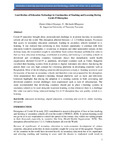| dc.contributor.author | Onyango, Daniel Oduor | |
| dc.contributor.author | Mhagama, Sr. Michaela | |
| dc.date.accessioned | 2022-05-04T14:43:36Z | |
| dc.date.available | 2022-05-04T14:43:36Z | |
| dc.date.issued | 2022-04 | |
| dc.identifier.issn | 2707-6741 | |
| dc.identifier.uri | http://ir.mksu.ac.ke/handle/123456780/12585 | |
| dc.description.abstract | Covid-19 pandemic brought about unprecedented challenge to in person learning in secondary schools all over the world. This disruption affected between 1.2 -1.5 billion learners. To ensure that access to secondary education continued, learning in secondary schools transited to e-learning. It was realized that continuing to deny learners opportunity to continue with their education would be catastrophic. It would lead to dropouts and other undesirable outputs. In this desktop study, the researchers sought to consolidate from various literature published in order to find out how education technology contributed to teaching and learning in secondary schools in developed and developing countries. Literature shows that immediately world health organization declared Covid-19 as pandemic, developed countries such as United Kingdom switched their learning systems from in person to digital. Literature also shows that during the period, there was very high demand for e-learning platforms in developing countries such as Bangladesh. Most of the developing countries did not possess a ready e- learning system to cater for majority of learners in secondary schools and therefore were not prepared for this disruption. After preparations they adopted e-learning through platforms such as radio and television. Literature highlights that during the adoption of e-learning systems in both developing and developed countries several challenges were experienced such as lack of infrastructure. The study recommended that developing countries should put in place e-learning systems in secondary schools to be used alongside in person learning so that whenever there is a challenge like what was and is being witnessed during Covid 19 disruption they can quickly switch to e-learning. | en_US |
| dc.language.iso | en_US | en_US |
| dc.publisher | Machakos University Press | en_US |
| dc.subject | Education technology | en_US |
| dc.subject | Digital education | en_US |
| dc.subject | E-learning and covid-19 | en_US |
| dc.subject | Online learning, disruption | en_US |
| dc.title | Contribution of Education Technology to Continuation of Teaching and Learning During Covid-19 Disruption | en_US |
| dc.type | Article | en_US |

